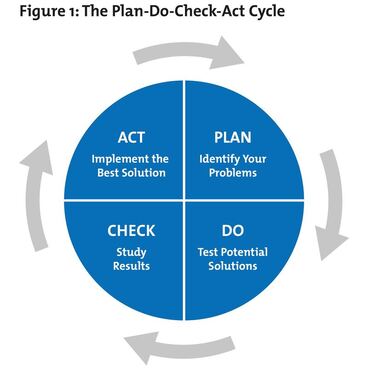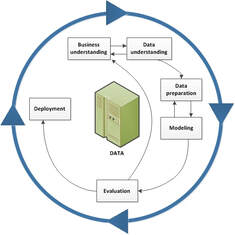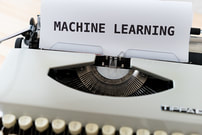 From Open-AI blog: DALL-E is a 12-billion parameter version of GPT-3 trained to generate images from text descriptions, using a dataset of text–image pairs. We’ve found that it has a diverse set of capabilities, including creating anthropomorphized versions of animals and objects, combining unrelated concepts in plausible ways, rendering text, and applying transformations to existing images. Some of the images created from text are incredible:  You can request to join the waitlist here I have waited a few weeks and have not heard back. I proposed to research cybersecurity and AI through general exploration. The concept would be to apply behavioral analysis and technique to identify trends, anomalies before they become disruptive. I'm sure there are many more ideas. What are yours?
0 Comments
 Figure 1 - PDCA Model courtesy of The W. Edwards Deming Institute®. Figure 1 - PDCA Model courtesy of The W. Edwards Deming Institute®. Identifying a model or strategy to apply to produce maximum positive results is imperative. Consider our research is centered on emerging and existing technologies integrating the best processes. To optimize outcomes, the authors recommend a strategic framework in which to operate within. Below are two models many industrial and systems engineers will be familiar with, the PDCA and CRISP-DM. The third component is a focus on governance of data, configuration management, certification of data structures, and processes around presenting the integrity of the data science practice. The Plan, Do, Check, Act (PDCA) model is a suitable framework in which to manage solutions for business process, optimization, and platforms. Originating with Dr. William Edwards Deming in the 1950’s, the PDCA model gives us a continuous feedback loop. The “planning” phase centers on problem definition and identifying the data sources required, and affected processes. In the “do” phase, we build and deploy the solution. This may be a limited pilot, minimal viable product, prototype, or phased deployment with limited production impact. In the “check” phase, we assess the expectations, early results and have the opportunity to adjust. Many call this the “study” phase where we apply new techniques, alter the approach. Finally, the “act” phase completes the deployment and sets the new baseline. All four phases of the PDCA model have a continuous feedback loop to improve outcomes.  Figure 2 CRISP-DM Model Courtesy of IBM Figure 2 CRISP-DM Model Courtesy of IBM The CRISP-DM, which stands for Cross-Industry Standard Process for Data Mining, is an industry-proven way to guide data mining efforts. It combines business understanding, data understanding, data preparation, modeling, evaluation and deployment. The CRISP-DM model can be tailored and fit for use. Its strengths include a focus on business comprehension and how respective data sets align to business processes. It also identifies potential data specific problems such as missing data, error types, measurement errors, coding dependencies and inconsistencies, as well as metadata mismatches. Governance of the data, data structures, models, and runs will be required for preserving integrity of the solution over the life cycle of the system. One key characteristic of the governance model should be a “data lineage” feature to track the source data across languages, file systems, databases, platforms. While the discipline of data governance is new to many organizations, it is particularly well-suited for industrial and systems engineers to define the process, lean it out, and provide measurable insights. 
Mr. Crump is my vice president and he shared a generous announcement on the Dallas 500 list. It has been absolutely fantastic working for Mr. Crump.
He is a visionary that has a talent for developing high potential leaders. He allows me to innovate, apply new techniques, and investigate emerging technologies applicable to the Aerospace & Defense, Industrial Manufacturing, and Technology Services industries. His team has developed revolutionary services in robotic process automation, distributed ledger technology (blockchain), artificial intelligence, enterprise resource planning, human resources, cloud computing, and manufacturing systems. I am thankful to be part of his team and play a part in re-engineering our business, the A&D industry, and have a global impact.  Artificial Intelligence is one of the top new skills to learn and apply. Some experts suggest that we will rewrite the majority of applications to include components of artificial intelligence in the coming years. We have more platforms for learning and practical labs than ever before. Given these “MOOC” platforms have been available for a number of years, it is sometimes difficult to find appropriate content that is not “marchitecture.” According to Kaggle’s 2020 “State of Data Science and Machine Learning Survey”, 63% of data scientists look to Coursera for ongoing education, while 35% use Udemy and 30% use DataCamp. I wanted to share my favorite and meaty forums to learn, apply, and practice AI. Course Criteria
The Courses
Do you have other recommendations? Please share! In my next post, I will be sharing AI certifications. |
AuthorDirector Archives
January 2023
Categories
All
|
Photos from europeanspaceagency, ▓▒░ TORLEY ░▒▓, Lori_NY, Dean_Groom, dalecruse, Fin Cosplay & Amigurumi, Iain Farrell, erin_everlasting, palindrome6996, Easa Shamih (eEko) | P.h.o.t.o.g.r.a.p.h.y, markhillary, Matt McGee, Marc_Smith, woodleywonderworks, agustilopez, rachel_titiriga, SeaDave, cheri lucas., Caio H. Nunes, grabbingsand, Armchair Aviator, quinn.anya, Jennifer Kumar, billaday, edtechworkshop, chucknado, purpleslog, yugenro, christianeager, dground, GlasgowAmateur, expertinfantry, shixart1985 (CC BY 2.0), OiMax, Wilfried Martens Centre for European Studies, PEO, Assembled Chemical Weapons Alternatives, IBM Research, shixart1985, markus119, shixart1985, shixart1985, Wilfried Martens Centre for European Studies


 RSS Feed
RSS Feed
